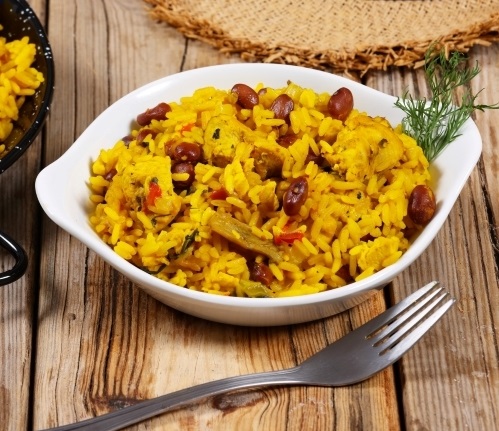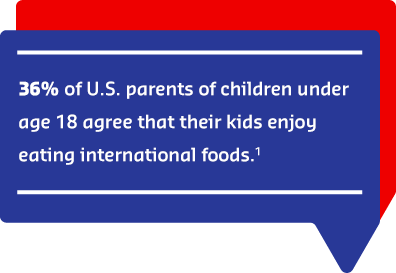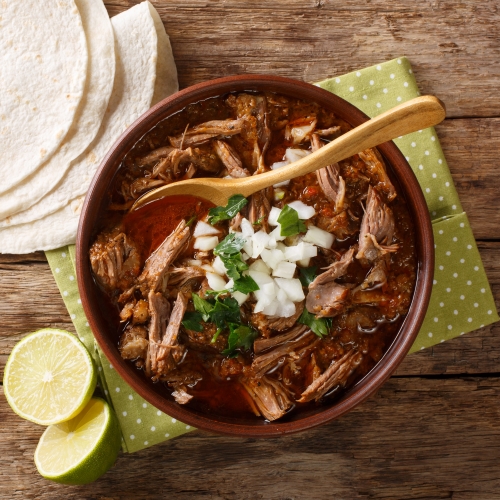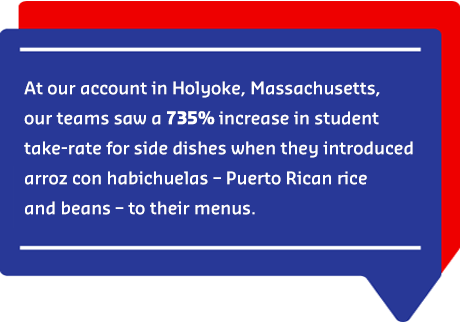There’s no denying that we are bearing witness to an unprecedented global exchange of food culture, driven in large part by the rise of web-based platforms, social networks and entertainment media, exposing younger generations to international cuisines and diverse experiences like never before.
 Take, for example, the latest viral food trend that propelled dalgona candy – a retro Korean street snack also known as ppopgi – to global fame. Featured on Netflix’s hit series Squid Game, the treat ignited a recent TikTok challenge, sending young users scrambling to carve a variety of simple shapes out of the candy under near-impossible time constraints. The viral buzz around birria, a spiced Mexican broth teeming with shredded meat, has likewise prompted a worldwide trend, making the once little-known stew ubiquitous amongst TikTok and Instagram users alike.
Take, for example, the latest viral food trend that propelled dalgona candy – a retro Korean street snack also known as ppopgi – to global fame. Featured on Netflix’s hit series Squid Game, the treat ignited a recent TikTok challenge, sending young users scrambling to carve a variety of simple shapes out of the candy under near-impossible time constraints. The viral buzz around birria, a spiced Mexican broth teeming with shredded meat, has likewise prompted a worldwide trend, making the once little-known stew ubiquitous amongst TikTok and Instagram users alike.
It’s clear that there’s a transformation underway in the preferences and appetites of children across the U.S. While social media platforms are surely playing a large part in this sea change, there are other reasons for Gen Z and Gen Alpha’s palate shifts.
Members of Generation Z were born between approximately 1995 and 2010. Generation Alpha follows, with birth years between 2010 and 2025.
 Mintel market research reveals that 46% of millennials – the parents of young students in school today – and a whopping 62% of young adults aged 18-22 cook international dishes at home.[1] And well over a quarter of U.S. parents of children under age 18 agree that their kids enjoy eating international foods, whether at home or dining out. The spike in adult interest around global cuisine is, no doubt, trickling down to influence the culinary curiosities of younger Gen Z and Gen Alpha.
Mintel market research reveals that 46% of millennials – the parents of young students in school today – and a whopping 62% of young adults aged 18-22 cook international dishes at home.[1] And well over a quarter of U.S. parents of children under age 18 agree that their kids enjoy eating international foods, whether at home or dining out. The spike in adult interest around global cuisine is, no doubt, trickling down to influence the culinary curiosities of younger Gen Z and Gen Alpha.
36% of U.S. parents of children under age 18 agree that their kids enjoy eating international foods.[1]
The evolving demographics of U.S. students are also contributing to a change in food-based preferences. A recent report by Hotwire Global indicates that in the U.S., 47% of people under age 18 do not identify as white – that’s almost half of all current students in the K-12 system.[2] Indeed, our student populations are becoming increasingly diverse, triggering substantial cultural shifts in eating habits across the K-12 school system.
 As today’s younger generations become more accustomed to eating culturally diverse foods, they’re also coming into contact with unconventional spices and bolder flavor profiles. Do kids still crave comfort foods? Of course. But they also want to experiment with these bold, spicy flavors; they want culturally representative menu options; and they’re either comfortable with, or at least curious about, diverse, international cuisines.
As today’s younger generations become more accustomed to eating culturally diverse foods, they’re also coming into contact with unconventional spices and bolder flavor profiles. Do kids still crave comfort foods? Of course. But they also want to experiment with these bold, spicy flavors; they want culturally representative menu options; and they’re either comfortable with, or at least curious about, diverse, international cuisines.
To meet the growing need for spice-infused flavors, our K-12 chefs and food service teams have been drumming up novel custom scratch sauces to ramp up the flavors of students’ favorite dishes. Thus far, we’ve introduced 14 different flavor variations, with over 400,000 servings in the 2021-2022 school year.
Our teams at Sodexo recognize how profoundly necessary it is to serve foods that resonate with students – foods that both pique their culinary interests and reflect the increasing diversity of their lived experiences. To successfully establish culturally representative dining programs that are age-appropriate and drive student engagement, we have continuously worked to reimagine our approach to K-12 menu design, always innovating to better meet the needs of the students we serve.
Culturally representative menus consist of foods that are tailored to address the culturally specific and diverse needs of the different districts and schools we serve.
Staying focused on locally-driven solutions
Conventional K-12 menu design ideation often takes place at the national corporate level. This top-down approach relies heavily on global insights and market trends to inform new menu concepts that eventually filter down to local operations.
But our teams recognized long ago that when it comes to targeting specific community needs, the top-down perspective presents a significant challenge: different communities have different needs, and what works for one district or one school may or may not work for another.
 This is why, at Sodexo, we prioritize a customizable approach to menu design that always starts with local choice and demand. In keeping with our people-centered philosophy, our menu ideation relies primarily on the personal insight and intimate knowledge of our local operators and frontline staff. Who better to tell us the needs of a particular school than the people interacting with students, parents and other community members on an everyday level? Who better to design solutions for a community than those already immersed within it?
This is why, at Sodexo, we prioritize a customizable approach to menu design that always starts with local choice and demand. In keeping with our people-centered philosophy, our menu ideation relies primarily on the personal insight and intimate knowledge of our local operators and frontline staff. Who better to tell us the needs of a particular school than the people interacting with students, parents and other community members on an everyday level? Who better to design solutions for a community than those already immersed within it?
Our menu development process empowers local operators – those with firsthand, site-specific knowledge – to solve for their community needs. Rather than starting at the national level, we look to our communities first to tell us their needs and the innovative solutions that they’ve already implemented to meet those needs.
This grassroots-inspired approach to menu design encourages local chefs who have already designed culturally representative recipes and menus that serve the needs of their student communities to share those recipes with our national teams. Once these local recipes trickle up, our national teams work to leverage our global Sodexo community using the full scale of our expansive resources, vendor supply networks, diversity groups and culinary experts to replicate successful, culturally responsive recipes across the country, filtering local solutions over to different districts with similar needs.
Culturally representative menu development, in action
To showcase our grassroots-inspired menu development in action, I want to spotlight the hands-on efforts currently underway at two of our operations:
Holyoke, Massachusetts
When it comes to tailoring solutions to serve a community’s unique cultural needs, our food service teams at Holyoke, MA, are leading the way.
 After attending school board meetings where community members voiced a growing desire for culturally specific recipes that represented the extensive Puerto Rican student populations within their district, our operators got to work right away. They called on our local chefs of Puerto Rican heritage to craft recipes and dishes that reflected and celebrated the diversity of their student communities. These chefs produced 15 new, culturally responsive entrees, bowls and side dishes, a few of which I’ve listed below:
After attending school board meetings where community members voiced a growing desire for culturally specific recipes that represented the extensive Puerto Rican student populations within their district, our operators got to work right away. They called on our local chefs of Puerto Rican heritage to craft recipes and dishes that reflected and celebrated the diversity of their student communities. These chefs produced 15 new, culturally responsive entrees, bowls and side dishes, a few of which I’ve listed below:
- Pernil al horno – roast pork shoulder with olive oil, lemon and other seasonings
- Arroz con habichuelas – rice and beans with tomato sauce
- Platanos – fried ripe plantains
- Sazon pork bowls – pork bowls with adobo, garlic and oregano
At our account in Holyoke, Massachusetts, our teams saw a 735% increase in student take-rate for side dishes when they introduced arroz con habichuelas – Puerto Rican rice and beans – to their menus.
The astounding leap in student take-rate for culturally representative recipes with bolder flavors just goes to show that younger generations really do value foods that speak to and reflect their diverse heritages.
The scratch menu items that have originated from our chefs at this site have already been funneled up through our national teams, where each recipe is undergoing culinary testing and review. Once this process is complete, these grassroots-inspired recipes will be socialized amongst districts across the nation with similar needs.
Schenectady, New York
Our teams in Schenectady, NY, are likewise leading a grassroots-fueled movement inspired by their community needs. The changes taking place at this operation have been driven, at large, by our very own frontline staff – staff who are the parents of children attending this school district.
While menu development at this site is still in progress, I’ve been working closely with our procurement teams and our local operators to craft halal recipes that reflect the religious needs of the Guyanese student population within this particular community.
Our long-term vision
While our grassroots approach to menu design is a consistently ongoing project, our long-term vision for K-12 menu development entails mobilizing our national and local teams in ever richer ways.
As we evolve, we’re looking to tap even more deeply into the culinary and cultural expertise of our global chefs, the knowledge of our diversity groups and the vast resources of our supply chains. And as these local recipes keep filtering out across the nation, we’re exploring new ways to preserve the community histories behind them. Because the local chefs, frontline staff and community members behind our menus deserve to be celebrated for their incredible efforts.
There’s no denying that our world is changing. Schools, businesses and other institutions alike need to step up and make changes that best serve and reflect the evolving needs of our increasingly diverse communities. This is the work it takes to build a better tomorrow and nurture stronger, healthier communities where students can thrive.
[1] Generation Z set to impact the future of food and drink | Mintel.com
[2] Understanding Generation Alpha - Hotwire Global
